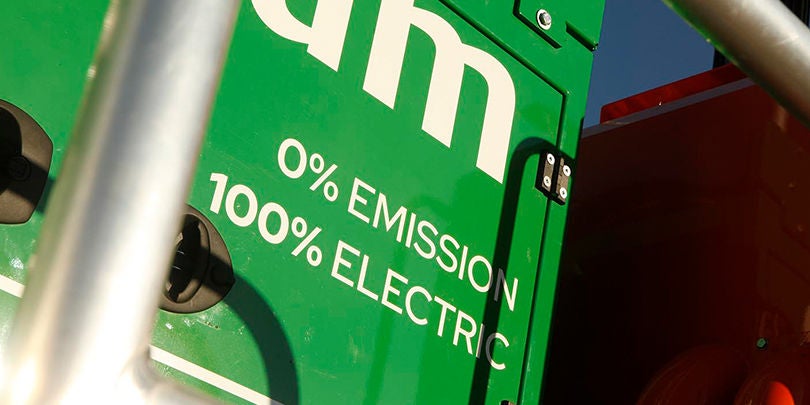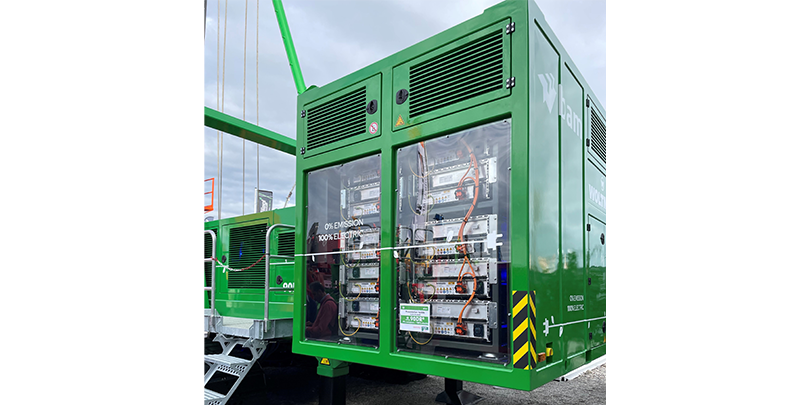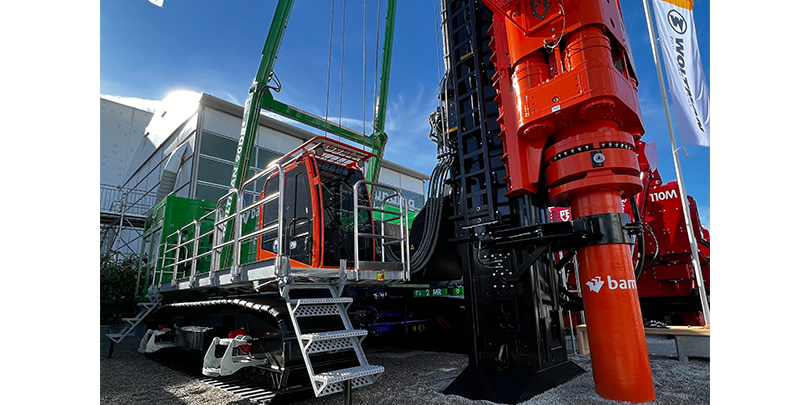Cleverly conceived colossus:
Fully electrified 90-ton drilling rig

Dutch manufacturer Dieseko, in collaboration with Webasto and partner Danfoss Editron, venture into electrification of a giant Woltman drilling rig. The civil engineering machine weighs in at 90 tons and can drive piles of up to 36 meters in length into the ground by drilling or driving.
These types of machines are needed on major construction sites around the world: Giant drills that drive piles into the ground or drill large holes that are then filled with concrete on site to provide a secure foundation for, amongst others, bridges or large buildings. Woltman drilling rigs have been around for 35 years, and since 2015, the brand has been part of large machinery specialist Dieseko, which is headquartered in Sliedrecht near Rotterdam.
To date, these drilling colossi have been diesel-powered – in terms of both mobility on the construction site and to drive the machines’ various working tools. But the desire to electrify construction machinery does not stop at these heavyweights. Some countries, like the USA (California), Norway and the Netherlands, are demanding zero-emission construction sites as early as 2025 or 2030. Nitrogen emission is a particular problem on construction sites, but carbon dioxide emissions must, of course, also be reduced as quickly and extensively as possible.
Electric construction machines pay off
The Dutch government subsidizes the purchase of electric construction machinery with attractive grants of up to 40 percent of the price difference compared to a new diesel-powered machine. The electric versions might be more expensive to purchase, but when their cost is evaluated over their entire service life, they actually deliver an attractive financial proposition. “On the one hand, diesel is going to become even more expensive, while on the other, there are certain tenders that you can only win these days if you use equipment that ensures zero on-site emissions,” explains Dirk Smulders, CEO of Dieseko.
A further benefit of electric propulsion is that the motor only consumes energy when it is operating. Diesel engines work practically throughout the day, even when they are only running in “standby” mode. Woltman’s best-seller in the 90-ton weight class is the first deep drilling rig that Dieseko has electrified in partnership with the Dutch engineering company VSE and Webasto, and it did so in just twelve months. “We initially considered electrification five years ago, but it took us a while to take all of the details into consideration and find the right partners,” reflects Smulders. Dieseko’s development engineers’ primary focus was not only on reducing emissions, but also reducing noise, vibrations and energy consumption. “We want to remain a technology leader, so we employ outside-the-box thinking to achieve the best quality,” says Smulders. The first 90 tons electric drilling rig will be delivered to a large, renowned and sustainably committed construction company in The Netherlands.

High quality in the choice of partners
Dieseko has set high standards for the chosen electrification project suppliers. The electric motors are supplied by Danfoss Editron, and the battery solution comes from Webasto.
“Webasto impressed us as a partner. Firstly, because its battery packs are very safe and extremely robust – this is particularly important because our drilling rigs always generate vibrations – and secondly, the thermal management solution for the batteries and cab has been achieved in a very clever manner,” explains Smulders.
“Our machines and their operators must be able to work safely and reliably on construction sites, so we have set high quality standards for our partners as well.” For Webasto, this is the project with the most battery packs in one vehicle or machine to date.

The Idea: divide the battery packs into two
The Woltman 90DRe uses 36 standard battery packs from Webasto. Six of these are permanently installed in the machine, separately from the others, and supply power to a small drive motor that allows the machine to travel short distances on the construction site.
A patent is pending for this energy efficient setup. The other 30 packs provide the immense capacity of power required for drilling or pile driving. A clever feature is that these battery packs can be removed and transported separately. This makes it easier to transfer the machine from one construction site to the next and allows discharged batteries to be replaced with charged ones.
Moreover, their weight of almost 15 tons provides the necessary counterbalance for the drilling rig. “Collaboration with VSE and Webasto to develop the interfaces between the machine, the Danfoss drive train and the power supply from the batteries proceeded smoothly. It was a real pleasure,” says Smulders.

Well thought-out battery concept
The number of battery packs is designed to provide sufficient power for an average workday on the construction site, i. e. around eight to ten hours. They can then be charged overnight with up to 90 kilowatt per hour. Their energy content is 35 kilowatt hours each – so in total, the batteries provide 1.2 megawatt hours of power capacity when fully charged. “Our machines are often the first to arrive on a construction site to start working. The challenge with this machine is to have sufficient grid power available at the site to ensure overnight charging ability. Currently this is not available at every job site, but with the introduction of these types of electric machines, we expect grid power availability will be ramped up”, explains Smulders.
Webasto’s batteries are extremely robust (vibration and shock tested to 100 kilonewtons) and are well protected by an extra box. Moreover, they can be cooled within the system, which guarantees their performance even in hot environments and under continuous load. The batteries are controlled by a central battery management system in the form of so-called vehicle interface boxes (VIBs). The VIBs from Webasto also serve as a communication interface between the battery system and the vehicle.
To ensure that the batteries are always kept within their optimum operating temperature range of between 15 and 35 degrees Celsius, Dieseko has also opted for the Plug & Play thermal management system from Webasto. This ensures the best possible energy conservation in everyday use and a long battery pack service life. The system also provides heating and air conditioning for the operator cabin, thereby delivering a single solution for all thermal tasks.
And will electrification of Woltman machines stop there? According to Smulders: no; plans for further machines are already on the drawing board and based on requests of key customers. “For this, we would like to expand upon the expertise we have gained together,” says Smulders.










